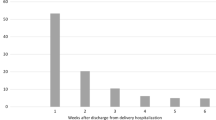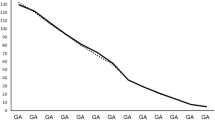Abstract
Objective
To examine the association between severe maternal morbidity (SMM) and infant health using the additional infant costs and length of stay (LOS) as markers of added clinical complexity.
Study design
Secondary data analysis using California linked birth certificate-patient discharge data for 2009–2011 (N = 1,260,457). Regression models were used to estimate the association between SMM and infant costs and LOS.
Results
The 16,687 SMM-exposed infants experienced a $6550 (33%) increase in costs and a 0.7 (18%) day increase in LOS. Preterm infants had ($11,258 (18%) added costs and 1.3 days (8.1%) longer LOS) than term infants ($2539 (38%) added costs and 0.5 days (22%) longer LOS).
Conclusions
SMM was associated with increased infant costs and LOS, suggesting that SMM may have adverse health effects for infants, including term infants. The relatively larger effect on costs indicates an increase in treatment intensity (clinical severity) greater than additional LOS.
This is a preview of subscription content, access via your institution
Access options
Subscribe to this journal
Receive 12 print issues and online access
$259.00 per year
only $21.58 per issue
Buy this article
- Purchase on Springer Link
- Instant access to full article PDF
Prices may be subject to local taxes which are calculated during checkout


Similar content being viewed by others
References
Centers for Disease Control and Prevention. Severe maternal morbidity in the United States [Internet]. [updated 2017 Nov 27; cited 2018 Oct 2]. Available from: https://www.cdc.gov/reproductivehealth/maternalinfanthealth/severematernalmorbidity.html
Centers for Disease Control and Prevention. Severe maternal morbidity indicators and corresponding ICD codes during delivery hospitalizations [Internet]. [updated 2018 Aug 21; cited 2018 Oct 2]. Available from: https://www.cdc.gov/reproductivehealth/maternalinfanthealth/smm/severe-morbidity-ICD.htm
Centers for Disease Control and Prevention. Maternal mortality [Internet]. [cited 2020 Jul 8]. Available from: https://www.cdc.gov/nchs/maternal-mortality/index.htm
Aoyama K, Park AL, Davidson AJF, Ray JG. Severe maternal morbidity and infant mortality in Canada. Pediatrics. 2020;146:e20193870.
Kilpatrick SJ, Abreo A, Gould J, Greene N, Main EK. Confirmed severe maternal morbidity is associated with high rate of preterm delivery. Am J Obstet Gynecol. 2016;215:233.e1–7.
Phibbs CS, Schmitt SK, Cooper M, Gould JB, Lee HC, Profit J, et al. Birth hospitalization costs and days of care for mothers and neonates in California, 2009-2011. J Pediatr. 2019;204:118–25.
Herrchen B, Gould JB, Nesbitt TS. Vital statistics linked birth/infant death and hospital discharge record linkage for epidemiological studies. Comput Biomed Res. 1997;30:290–305.
California Office of Statewide Health Planning and Development. Hospital annual financial data 2017 [Internet]. [cited 2016 Aug 25]. Available from: https://www.oshpd.ca.gov/HID/Hospital-Financial.asp
Peterson C, Xu L, Florence C, Grosse SD, Annest JL. Professional fee ratios for US hospital discharge data. Med Care. 2015;53:840–9.
Crawford M, Church J, Akin B, eds. Bureau of Labor Statistics. 2017 Producer Price Index [Internet]. [cited 2018 Apr 23]. Available from: https://www.bls.gov/bls/news-release/ppi.htm#2017
Dunn A, Grosse SD, Zuvekas SH. Adjusting health expenditures for inflation: a review of measures for health services research in the United States. Health Serv Res. 2018;53:175–96.
Grobman WA, Bailit JL, Rice MM, Wapner RJ, Reddy UM, Varner MW, et al. Frequency of and factors associated with severe maternal morbidity. Obstet Gynecol. 2014;123:804–10.
Callaghan WM, Creanga AA, Kuklina EV. Severe maternal morbidity among delivery and postpartum hospitalizations in the United States. Obstet Gynecol. 2012;120:1029–36.
Leonard SA, Main EK, Scott KA, Profit J, Carmichael SL. Racial and ethnic disparities in severe maternal morbidity prevalence and trends. Ann Epidemiol. 2019;33:30–6.
Leonard SA, Kennedy CJ, Carmichael SL, Lyell DJ, Main EK. An expanded bbstetric comorbidity scoring system for predicting severe maternal morbidity. Obstet Gynecol. 2020;136:440–9.
Main EK, Leonard SA, Menard MK. Association of maternal comorbidity with severe maternal morbidity: a cohort study of California mothers delivering between 1997 and 2014. Ann Intern Med. 2020;173:S11–S8.
Bateman BT, Mhyre JM, Hernandez-Diaz S, Huybrechts KF, Fischer MA, Creanga AA, et al. Development of a comorbidity index for use in obstetric patients. Obstet Gynecol. 2013;122:957–65.
Howell EA, Janevic T, Hebert PL, Egorova NN, Balbierz A, Zeitlin J. Differences in morbidity and mortality rates in black, white, and Hispanic very preterm infants among New York City hospitals. JAMA Pediatr. 2018;172:269–77.
Howell EA, Janevic T, Blum J, Zeitlin J, Egorova NN, Balbierz A, et al. Double disadvantage in delivery hospital for Black and Hispanic women and high-risk infants. Matern Child Health J. 2020;24:687–93.
Howell EA, Egorova NN, Janevic T, Brodman M, Balbierz A, Zeitlin J, et al. Race and ethnicity, medical insurance, and within-hospital severe maternal morbidity disparities. Obstet Gynecol. 2020;135:285–93.
Mujahid MS, Kan P, Leonard SA, Hailu EM, Wall-Wieler E, Abrams B, et al. Birth hospital and racial and ethnic differences in severe maternal morbidity in the state of California. Am J Obstet Gynecol. 2021;224:219.e1–219.e15.
Howell EA, Egorova NN, Balbierz A, Zeitlin J, Hebert PL. Site of delivery contribution to black-white severe maternal morbidity disparity. Am J Obstet Gynecol. 2016;215:143–52.
Girsen AI, Sie L, Carmichael SL, Lee HC, Foeller ME, Druzin ML, et al. Rate and causes of severe maternal morbidity at readmission: California births in 2008-2012. J Perinatol. 2020;40:25–9.
Petersen EE, Davis NL, Goodman D, Cox S, Mayes N, Johnston E, et al. Vital signs: pregnancy-related deaths, United States, 2011-2015, and strategies for prevention, 13 states, 2013-2017. MMWR Morb Mortal Wkly Rep. 2019;68:423–9.
Kaiser Family Foundation. Hospital adjusted expenses per inpatient day by ownership [Internet]. [cited 2016 Dec 13]. Available from: http://kff.org/other/state-indicator/expenses-per-inpatient-day-by-ownership/?currentTimeframe=0
Phibbs CM, Kozhimannil KB, Leonard S, Lorch SA, Main EK, Schmitt SK, et al. A comprehensive analysis of the costs of severe maternal morbidity. Womens Health Issues. https://doi.org/10.1016/j.whi.2021.12.006.
Janevic T, Zeitlin J, Egorova N, Hebert PL, Balbierz A, Howell EA. Neighborhood racial and economic polarization, hospital of delivery, and severe maternal morbidity. Health Aff. 2020;39:768–76.
Funding
Partial support provided by NIH/NICHD R01s HD084819 and HD099197.
Author information
Authors and Affiliations
Contributions
CSP jointly (with CMP) conceived the initial idea of a project examining the costs associated with Severe Maternal Morbidity (SMM), collaborated with all of the other authors to design the study, supervised the analyses of the data, and jointly drafted the initial manuscript (with CMP), and reviewed and revised the manuscript. CMP jointly conceived the initial idea for the project, collaborated with all of the other authors to design the study, jointly drafted the initial manuscript, and reviewed and revised the manuscript. KBK, SAL, SAL, and Main all participated in the design of the study and reviewed and revised the manuscript. SKS participated in the design of the study, carried out all of the data analyses, and reviewed and revised the manuscript. CSP was PI for both the grants that provided partial support to this manuscript (HD084819 and HD099197); SAL was co-PI for HD084819.
Corresponding author
Ethics declarations
Competing interests
The authors declare no competing interests.
Additional information
Publisher’s note Springer Nature remains neutral with regard to jurisdictional claims in published maps and institutional affiliations.
Supplementary information
Rights and permissions
About this article
Cite this article
Phibbs, C.M., Kozhimannil, K.B., Leonard, S.A. et al. The effect of severe maternal morbidity on infant costs and lengths of stay. J Perinatol 42, 611–616 (2022). https://doi.org/10.1038/s41372-022-01343-3
Received:
Revised:
Accepted:
Published:
Issue Date:
DOI: https://doi.org/10.1038/s41372-022-01343-3
This article is cited by
-
Validation of a measure of hospital maternal level of care for the United States
BMC Health Services Research (2024)
-
Pre-pregnancy Weight and Racial-Ethnic Disparities in Pregnancy-Associated Conditions in the State of Georgia: A Population-Based Study
Journal of Racial and Ethnic Health Disparities (2024)
-
Using Prevention Research to Reduce Racial Disparities in Health Through Innovative Funding Strategies: The Case of Doula Care
Prevention Science (2024)



